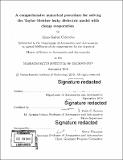| dc.contributor.advisor | Paulo C. Lozano. | en_US |
| dc.contributor.author | Gallud Cidoncha, Ximo. | en_US |
| dc.contributor.other | Massachusetts Institute of Technology. Department of Aeronautics and Astronautics. | en_US |
| dc.date.accessioned | 2020-03-23T18:10:01Z | |
| dc.date.available | 2020-03-23T18:10:01Z | |
| dc.date.copyright | 2019 | en_US |
| dc.date.issued | 2019 | en_US |
| dc.identifier.uri | https://hdl.handle.net/1721.1/124177 | |
| dc.description | Thesis: S.M., Massachusetts Institute of Technology, Department of Aeronautics and Astronautics, 2019 | en_US |
| dc.description | Cataloged from PDF version of thesis. | en_US |
| dc.description | Includes bibliographical references (pages 109-112). | en_US |
| dc.description.abstract | Electrosprays in the pure-ion mode are of particular interest to space propulsion because of its ability to produce high specific impulse and efficient electrical-to-kinetic energy transformation, together with its simplicity and compactness. Unlike electrospray emitters operating in the droplet mode, pure-ion emission is known to be very dependent on the meniscus configuration, and consequently permissible under specific circumstances, mostly related to its stability. This has conferred pure-ion sources with an increased difficulty in controlling and predicting fundamental beam characteristics such as current emitted, while also making it hard to establish the conditions that need to be met by the device structure to support adequate ion emission. The use of Ionic Liquids has moderately alleviated some of these limitations, but still, the physics that lie behind electrosprays in the pure-ion regime remain considerably elusive. | en_US |
| dc.description.abstract | This lack of fundamental knowledge has motivated past research on multiphysics simulation frameworks, mostly based on a modified version of the Taylor-Melcher leaky-dielectric model to account for the characteristics of charge evaporation in the pure-ion regime. Findings in these frameworks have unveiled a family of stable solutions for the problem of a volumetrically-unconstrained emitting source. Stability is found under specific sets of circumstances involving structure of the feeding architecture that favours high hydraulic impedances, small meniscus characteristic lengths and limited range of operating voltages. The lack of previous work has limited validation efforts in the literature to simplified physical models and a limited subset of physical input parameters. | en_US |
| dc.description.abstract | Besides, implementation limitations of commercial solvers (e.g, meshing resolution and no parallelization), have hindered the exploration of menisci stability in important ranges of parameters such as high contact line radius or high values of the external electric field. In this thesis we provide a comprehensive numerical finite element framework to solve the Taylor-Melcher leaky dielectric model with charge evaporation to find static equilibrium shapes of pure-ion emitting meniscus, we validate the shapes obtained with the results in previous work and provide an updated stability map for steady evaporation. | en_US |
| dc.description.statementofresponsibility | by Ximo Gallud Cidoncha. | en_US |
| dc.format.extent | 112 pages | en_US |
| dc.language.iso | eng | en_US |
| dc.publisher | Massachusetts Institute of Technology | en_US |
| dc.rights | MIT theses are protected by copyright. They may be viewed, downloaded, or printed from this source but further reproduction or distribution in any format is prohibited without written permission. | en_US |
| dc.rights.uri | http://dspace.mit.edu/handle/1721.1/7582 | en_US |
| dc.subject | Aeronautics and Astronautics. | en_US |
| dc.title | A comprehensive numerical procedure for solving the Taylor-Melcher leaky dielectric model with charge evaporation | en_US |
| dc.type | Thesis | en_US |
| dc.description.degree | S.M. | en_US |
| dc.contributor.department | Massachusetts Institute of Technology. Department of Aeronautics and Astronautics | en_US |
| dc.identifier.oclc | 1143741324 | en_US |
| dc.description.collection | S.M. Massachusetts Institute of Technology, Department of Aeronautics and Astronautics | en_US |
| dspace.imported | 2020-03-23T18:10:00Z | en_US |
| mit.thesis.degree | Master | en_US |
| mit.thesis.department | Aero | en_US |
